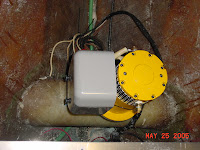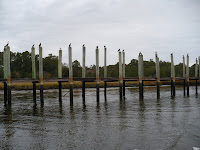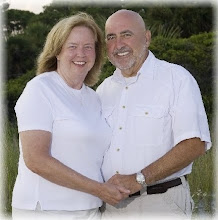 We decorated Windreka, said goodbye to our marina friends and departed South Carolina for colder northern weather on Friday afternoon, 6th December as a great fog was rolling in...reminded us of the foc'sle chantey, The Irish Rover. Friday night, we spent our first night in several weeks in a motel with a floor and a bed that didn't move...now that was exciting!
We decorated Windreka, said goodbye to our marina friends and departed South Carolina for colder northern weather on Friday afternoon, 6th December as a great fog was rolling in...reminded us of the foc'sle chantey, The Irish Rover. Friday night, we spent our first night in several weeks in a motel with a floor and a bed that didn't move...now that was exciting!We made it back to Joe's daughter, Jen's home in Maryland on Saturday, the 7th and friend Sunny Fitzgerald's annual Christmas party later that evening. Everyone wanted to know "how it was?" and our stock answers consisted of somewhat-but-not-too-exagerated descriptions of how cold, how windy and how tough it really was...then we told them the truth...we had the time of our lives and it was really a great experience. Much of the time we were met with puzzled expressions and we realized again that what we are doing is a bit unusual to our land friends. At least we hadn't run into snow until we returned to Maryland...making us realize why we left in the first place.
On Sunday, the 8th December, we left snowy Maryland for snowy Ohio and were home by late afternoon in cold, windy weather. We didn't have much time to think about the 80-degree weather in South Carolina as we had a refrigerator to restock, a house to decorate and preparations to make for Christmas visitors. Actually, Frank calls Joe every few days to remind him how nice it is in South Carolina and to listen to Joe tell him how cold it is in Ohio.
Since we returned, time has gone by quicker than we thought it would. We just looked at the calendar and realized we've been back home for almost two weeks and it's Christmas in four days...Holy Smoke...hope we've got all our Christmas shopping done!
 Family Dinner at the Refectory
Family Dinner at the Refectory Christmas is a moving experience this year. As mentioned, Sarah's son Cliff and his family were visiting with us last week and we had an early Christmas with both Sarah's children and their families while everyone was together. After Christmas, Joe (and maybe Sarah) will visit with Joe's daughter, Leanne and her family in St. Louis...then a visit with Joe's daughter, Jen and her family before we head for warmer weather in January...then a visit with Joe's son, Joe and his family whenever we get to Florida. We've decided it's impossible to get the entire clan together all at once and so we have to have family time in smaller bites.
Christmas is a moving experience this year. As mentioned, Sarah's son Cliff and his family were visiting with us last week and we had an early Christmas with both Sarah's children and their families while everyone was together. After Christmas, Joe (and maybe Sarah) will visit with Joe's daughter, Leanne and her family in St. Louis...then a visit with Joe's daughter, Jen and her family before we head for warmer weather in January...then a visit with Joe's son, Joe and his family whenever we get to Florida. We've decided it's impossible to get the entire clan together all at once and so we have to have family time in smaller bites.



 Bow Thruster Inside and Outside Views
Bow Thruster Inside and Outside Views


 We retired early, but the next couple of days have been eventful and we'll post the happenings on another post. This post is being written after the fact from a hotel room about 150 miles south of Richmond as we make our way over land on the next phase of our cruising activities.
We retired early, but the next couple of days have been eventful and we'll post the happenings on another post. This post is being written after the fact from a hotel room about 150 miles south of Richmond as we make our way over land on the next phase of our cruising activities.


























